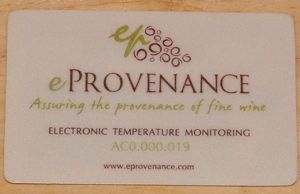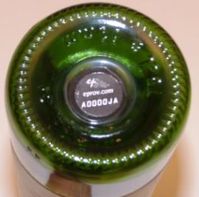“From farm to fork” is a catchphrase used to express a means of tracking animals from birth, through slaughter, and to the dinner plate—a process for which RFID is increasingly employed. Eric Vogt has started a company, eProvenance, offering a service for tracking fine wines “from château to consumer.” To that end, his company is employing a combination of semi-active (battery-assisted) and passive RFID technology, as well as specialized ink, which work in concert to track, authenticate and monitor bottles of wine.
A wine’s provenance is the record of its custody, authenticity and environmental exposure, from the time it was bottled to when it is consumed. Provenance plays a major role in a bottle of wine’s value; a well-recorded provenance can add 15 percent to wine’s value, says Vogt, and sometimes more. But the problem is that the historical records of most wines, he says, are full of holes.

For fine wines, it’s common for shippers to add temperature trackers to loads of wine—generally shipped via boat—as they make their way between continents, in order to know what range of temperatures the wine is exposed to while aboard the boat. This adds costs but without, contends Vogt, enough value: “The ocean shipping portion only counts for one third or one half of the journey,” he says. “It’s what happens when the case is off the boat that matters.” And because the temperature is tracked only during the boat portion of the wine’s journey, it does not provide the players in the wine’s supply chain—from winemakers to freight forwarders to distributors and sellers, and finally, consumers—a complete or accurate provenance.
Much of the data Vogt and his team at eProvenance have collected during pilot project, begun six months ago, supports this theory. The company is headquartered in Boston, with offices in Paris and the Bordeaux region of France. As part of the pilot, Vogt’s group glued battery-assisted passive 13.56 MHz RFID tags with integrated temperature sensors to the interior more than 1,200 wooden cases of wine shipped from nine winemakers in the Bordeaux region of France, to points in the United Kingdom, the United States and Japan. A shipment of wine from Bordeaux to Tokyo, for example, was kept well within a safe temperature range from the point of bottling, to a broker’s facility, onto a ship and during the many weeks it was in transit. When the load arrived in Tokyo, however, it was exposed to temperature well above the range that the wine industry considers safe for that particular type of wine, according to the temperature data log downloaded from the tags, which are set to record temperature three times per day.
The temperature-tracking tag that eProvenance places inside each case of wine is roughly the size of credit card and is made by KSW Microtec. It stores the temperature log on the tag’s 8-kilobit memory, which can hold up to 720 readings, according to Liz Churchill, eProvenance vice president of solutions. When set to record temperature three times her day, the tag’s battery can last for about one year, she says.
For the purposes of the current trial, says Vogt, the parties that receive the shipments of wine are asked to remove the tag from each case and send it back to eProvenance, which then downloads the temperature log and imports the data to its provenance database. In that database, the BAP tag’s ID is associated with the unique ID encoded to a passive, 13.56 MHz tag ISO 15693-compliant tag attached to each bottle inside the case. These tags are supplied by EmbedTech Industries and KSW Microtec.
The passive tags are used to identify and authenticate each bottle and to link it to the case’s temperature-tracking tag and thereby to all shippers, distributors or brokers that handled that bottle. Consumers or any party in each bottle’s supply chain can look up the provenance for any tagged bottle by accessing the eProvenance Web site and keying in the ID number printed on the outside of the tag (which is encased in a plastic housing and adhered with a strong epoxy to the punt, or dimple at the bottom of the wine bottle. The number encoded to the inlay inside the tag is not the same number as that printed on the tag, but the two numbers are associated with each other in eProvenance’s back-end database.
Lastly, an invisible ink can be printed on the foil wrapper that covers the bottle’s cork. Using a small handheld device, the ink can be read by the receiving party in order authenticate that the wine has not be removed from the bottle and replaced with a lower-quality wine.
Vogt says he has worked with nine different wineries in the Bordeaux region for the pilot project. Because not all of the 1,200 tagged cases have reached their destinations, he does not expect to have all of the temperature data collected until late summer. Thus far, be says, about 60 percent of the parties that received the wine have gone to the trouble of returning the temperature tags to eProvenance. Once the company moves beyond pilot stage and acquires a network of customers, who may range from winemakers to distributors to retailers, these customers would likely acquire the RFID readers needed to collect the data from the tags themselves, and download the data collected to the eProvenance database.
Vogt says the benefits of the eProvenance concept are threefold: traceability, authentication and a history of the wine’s custody (right down to viewing the winery on Google maps and learning exactly when and where the grapes were grown, when the blend was made, etc.).
But there will be some hesitation in the wine industry to adopt the system, he says, because the added visibility into a wine’s exposure to temperature also provides greater accountability from the supply chain partner responsible for the product if it becomes too hot or too cold. For that reason, Vogt has started looking at how eProvenance might also get into the business of offering insurance. “If we have enough data to understand temperature in global distribution channel, and also know which varietals are likely to be harmed at which temperature, we can offer insurance,” he proposes.
It’s a concept that the company plans to explore in coming weeks through meetings with experts in the wine industry and supply chain. He says at the end of the day, all parties should be interested in better, more-thorough temperature tracking of fine wines, because by identifying problem areas and finding ways to ensure product is store and transported under optimal conditions, the consumer will end up with better-tasting wines, and will want to acquire more.


